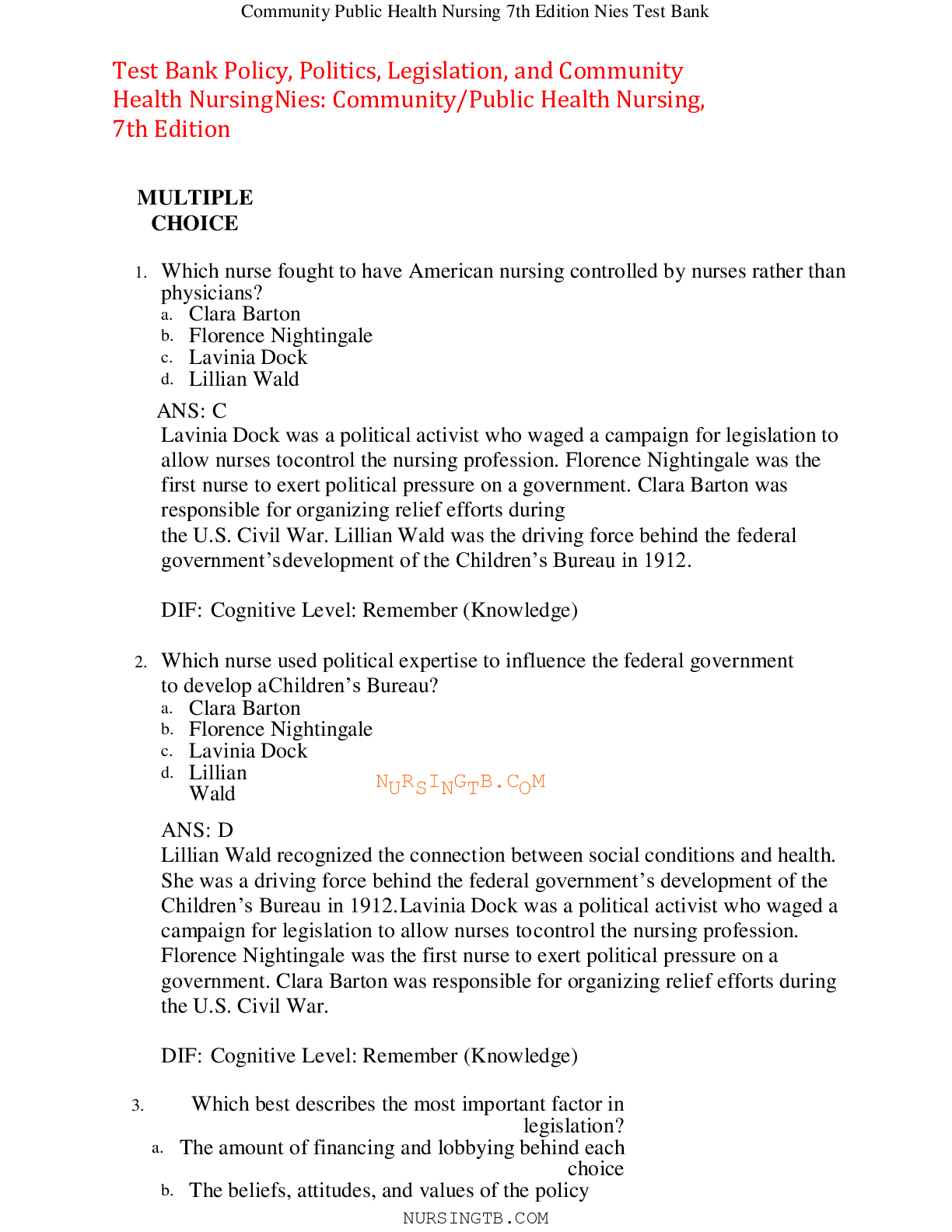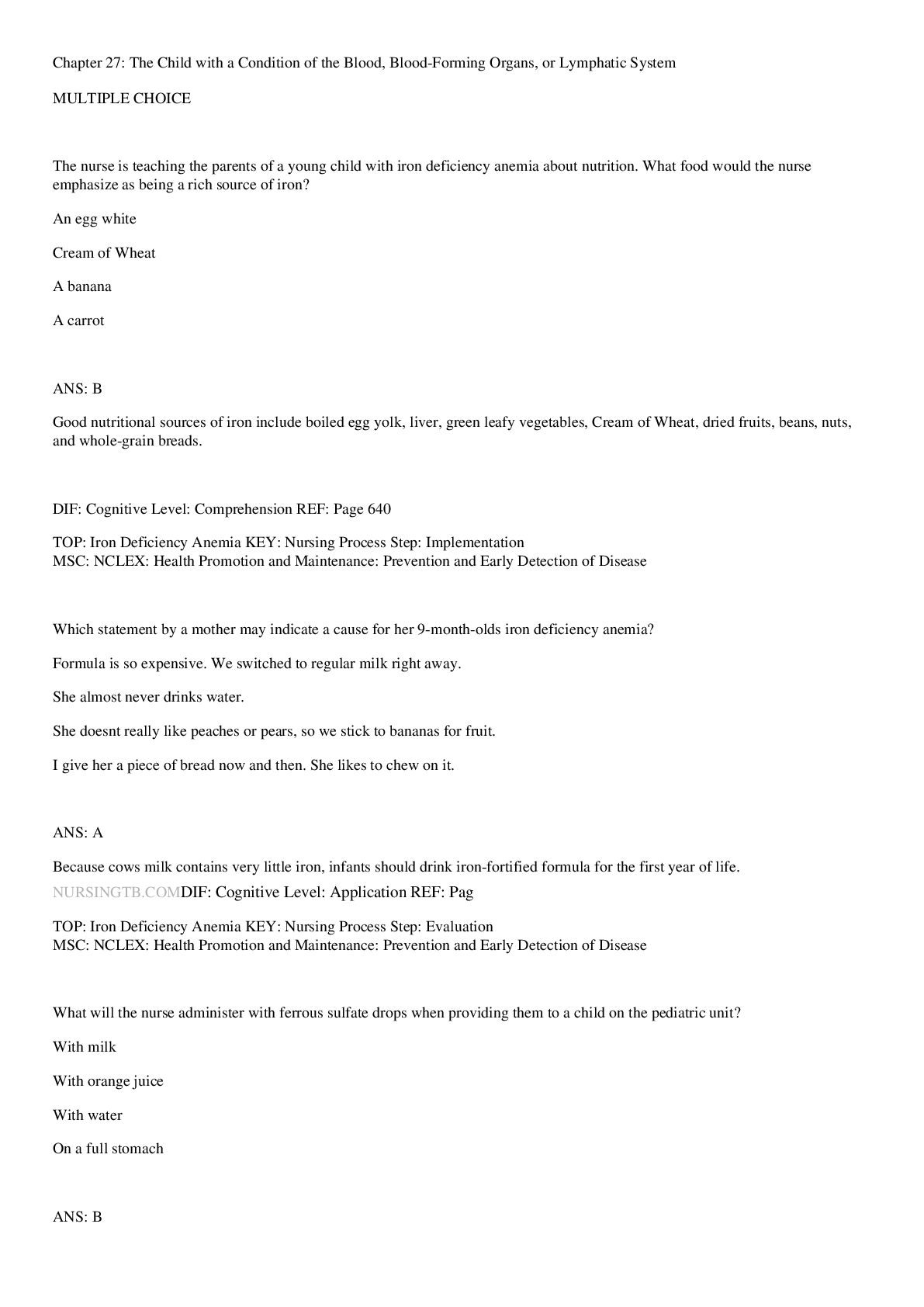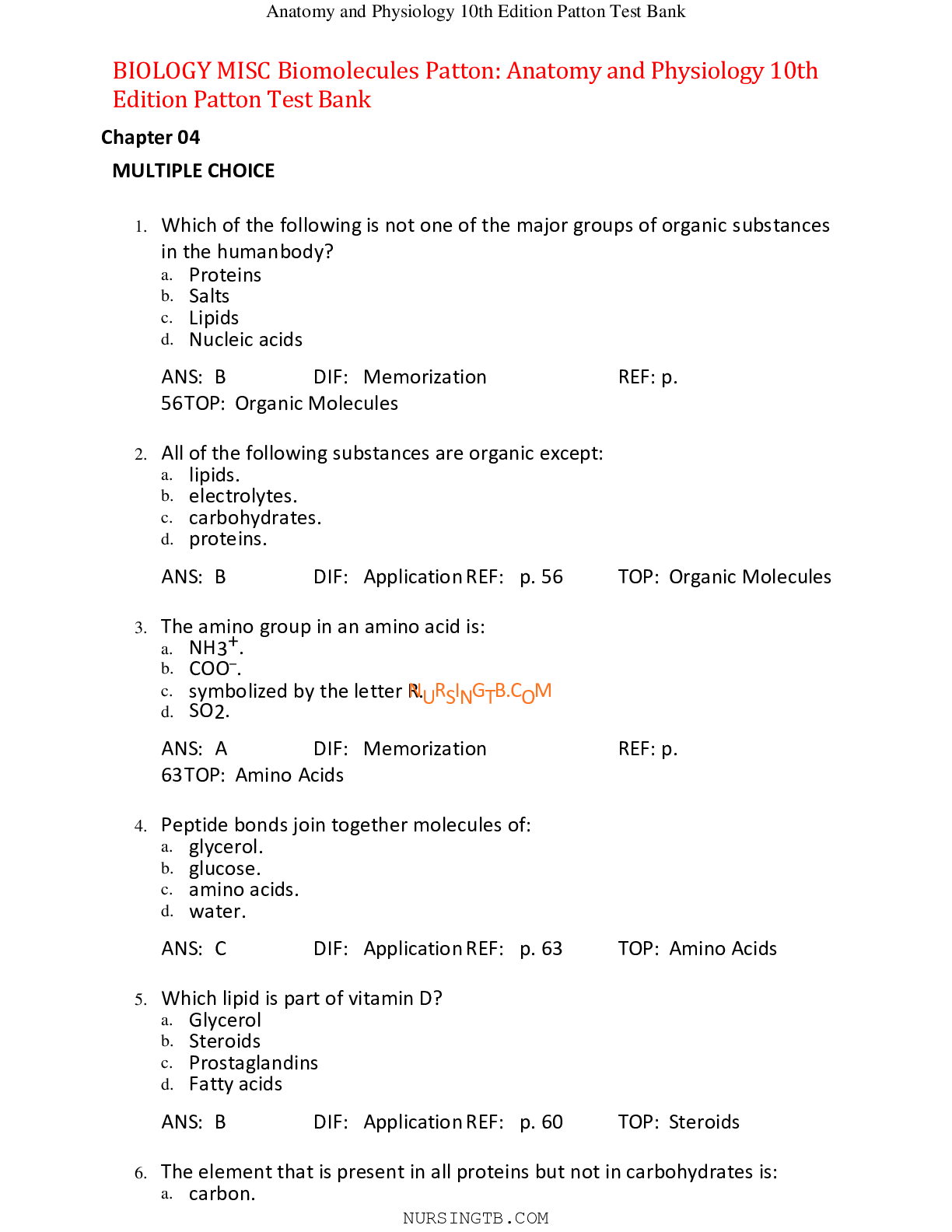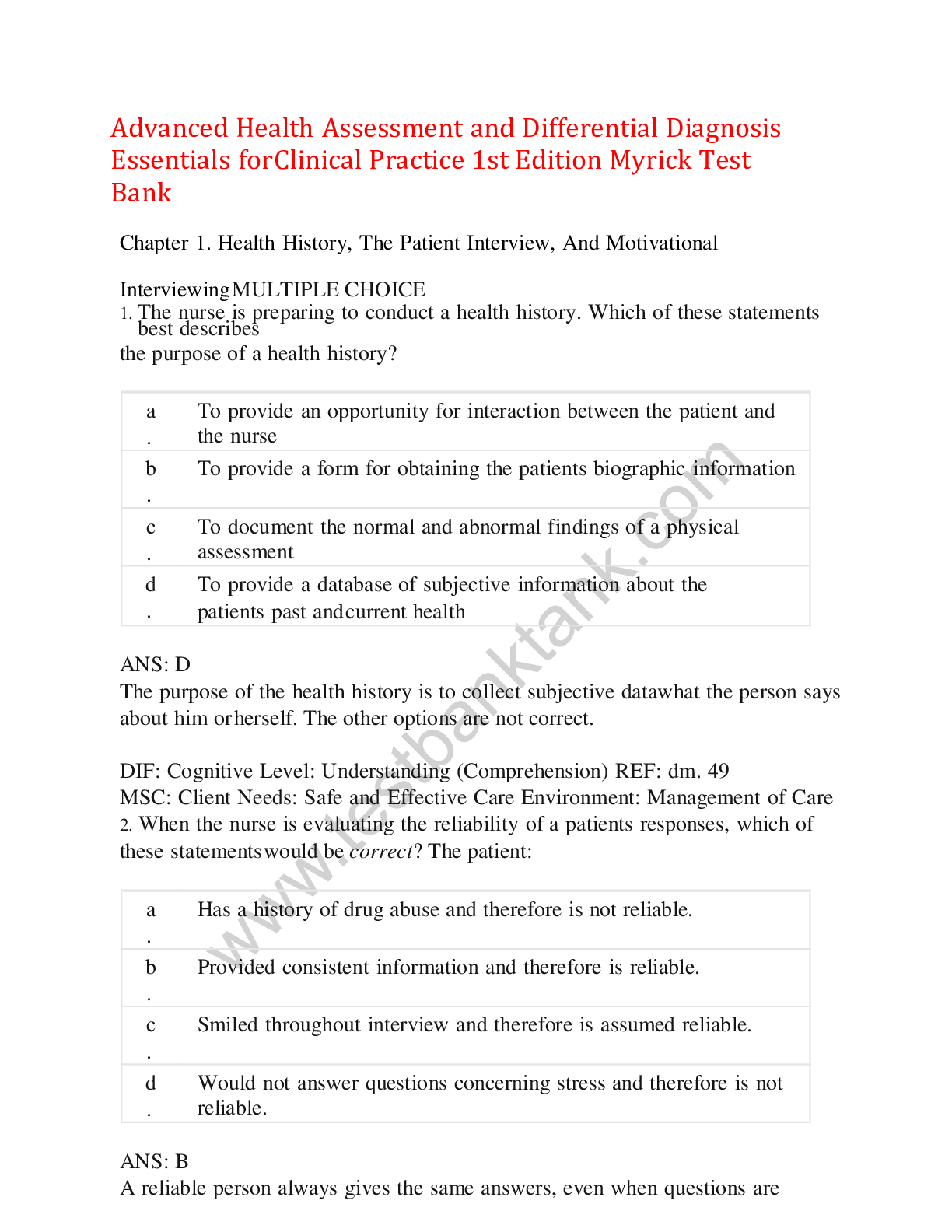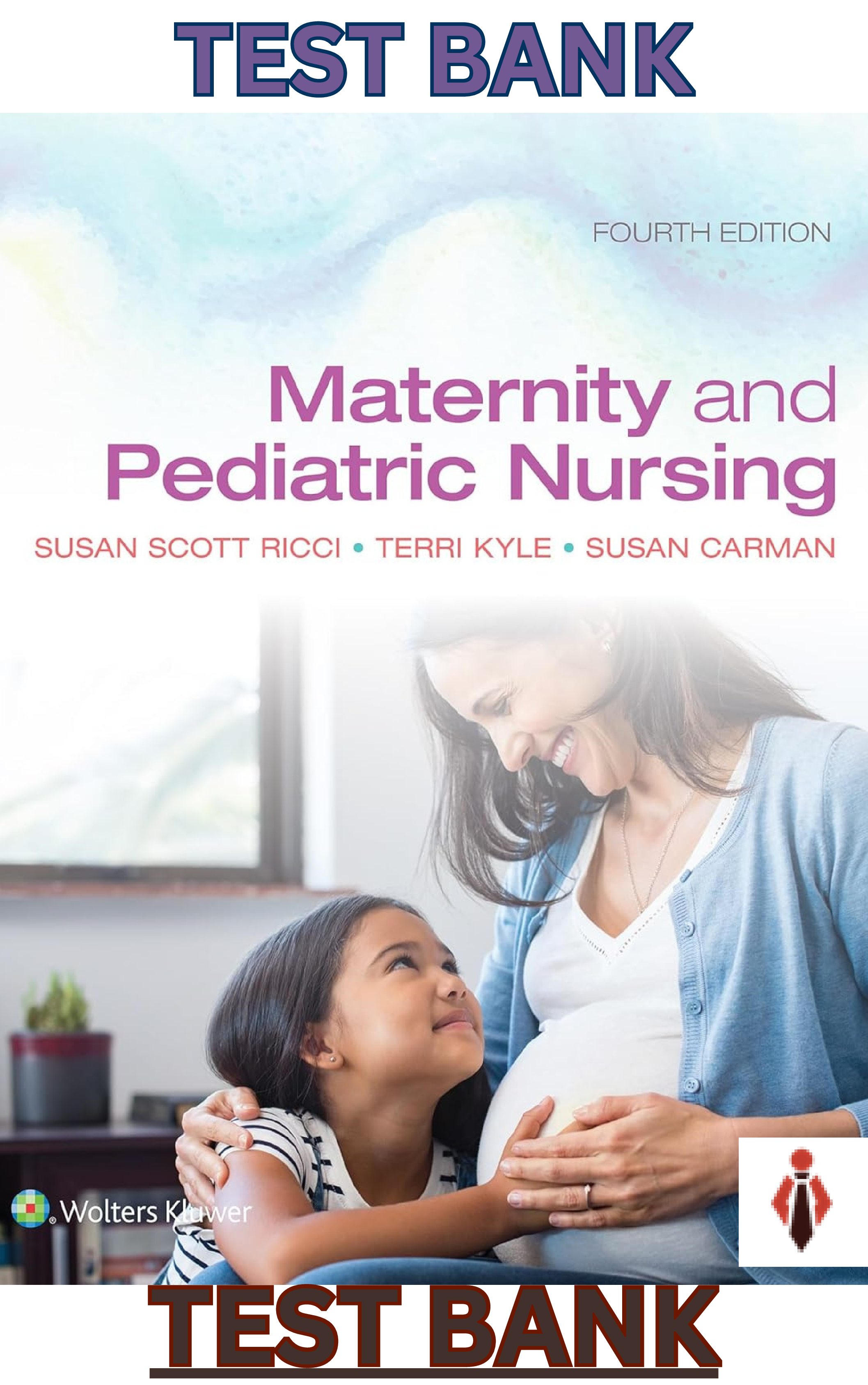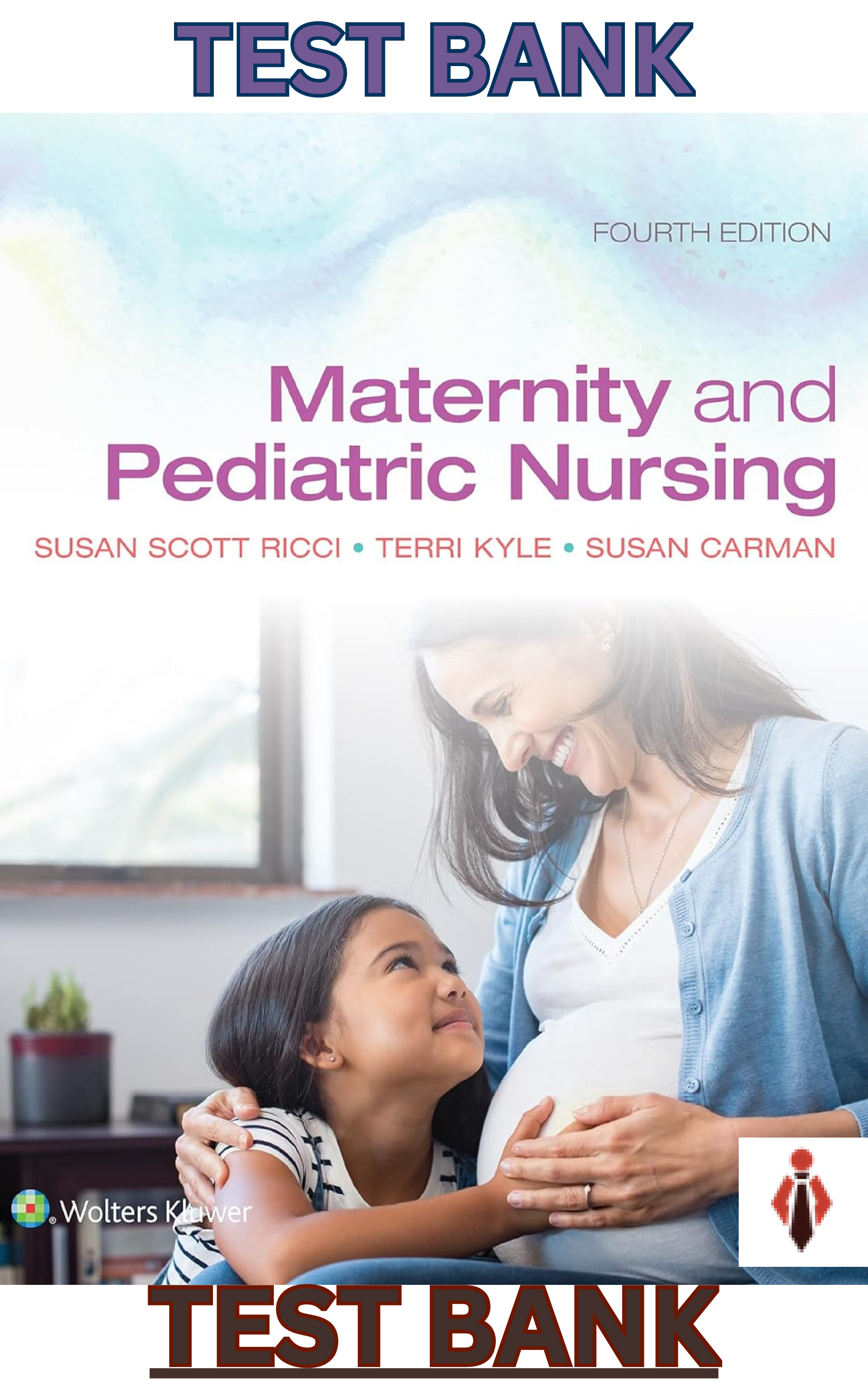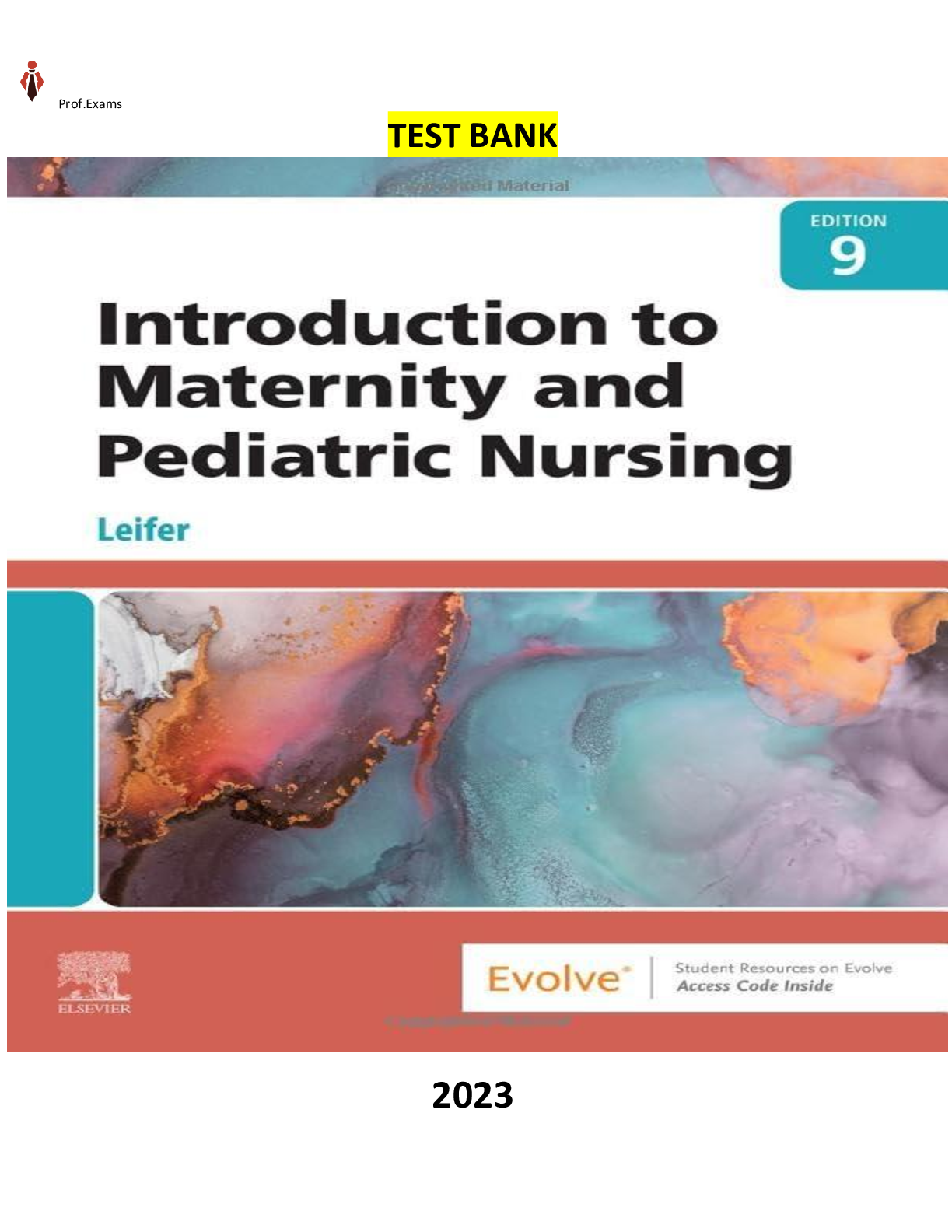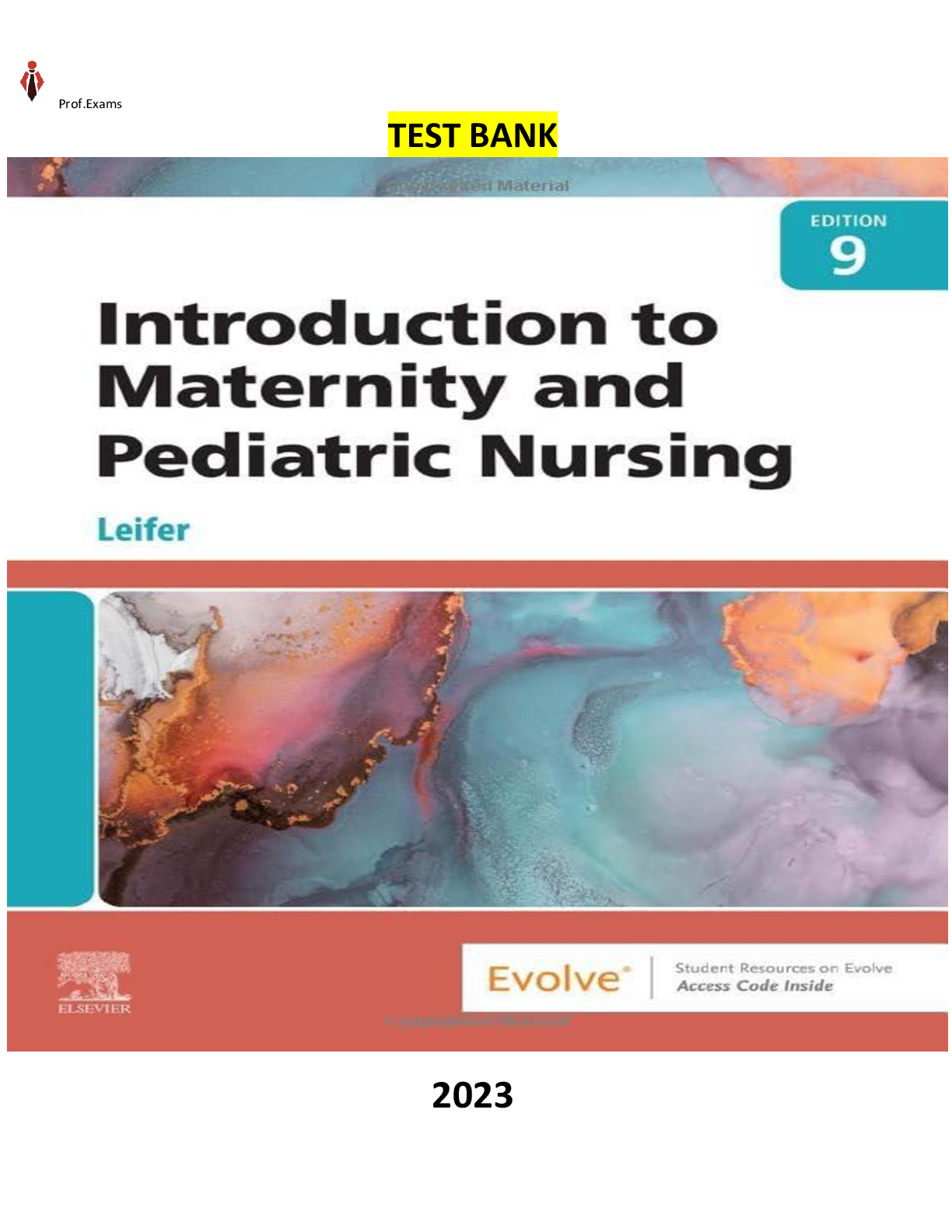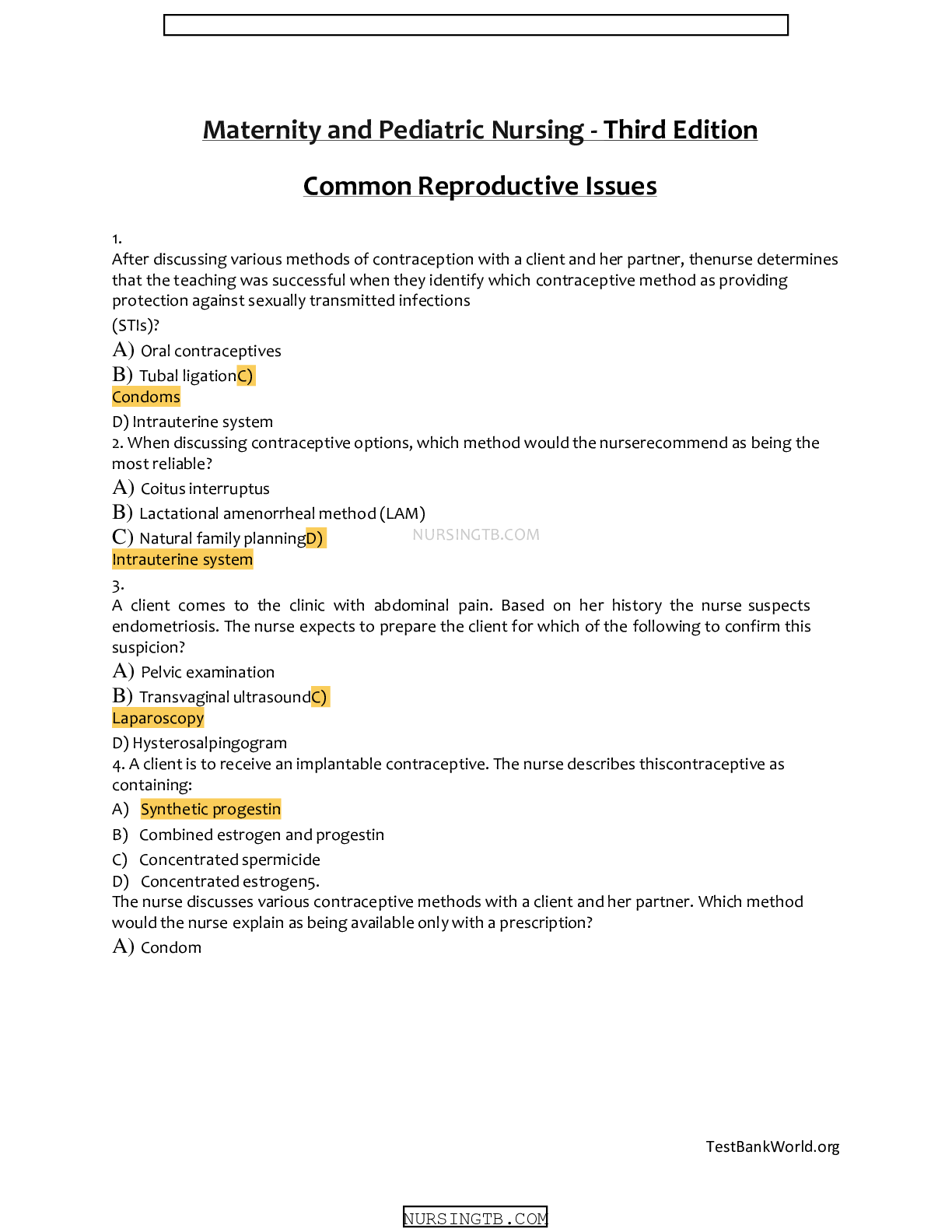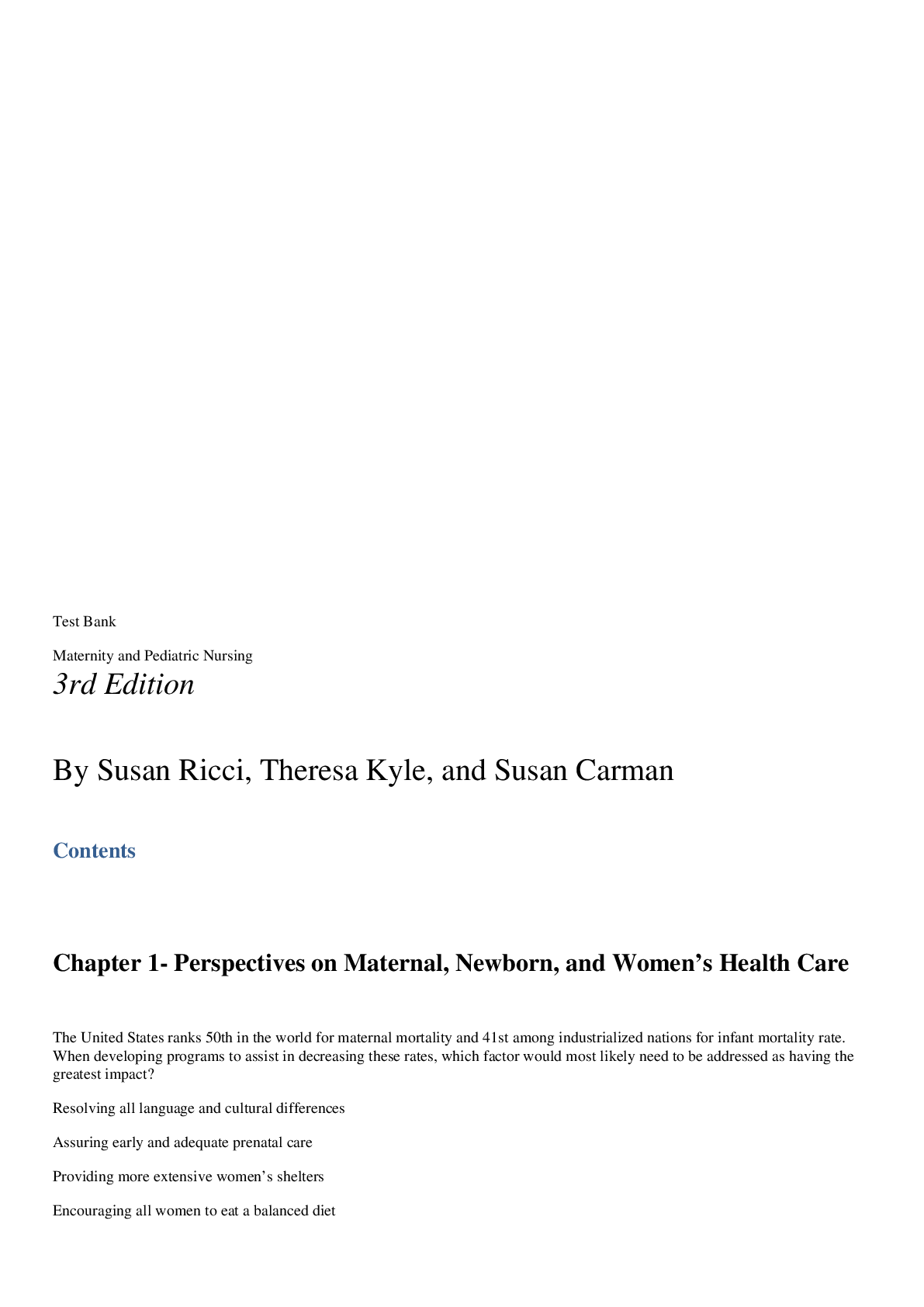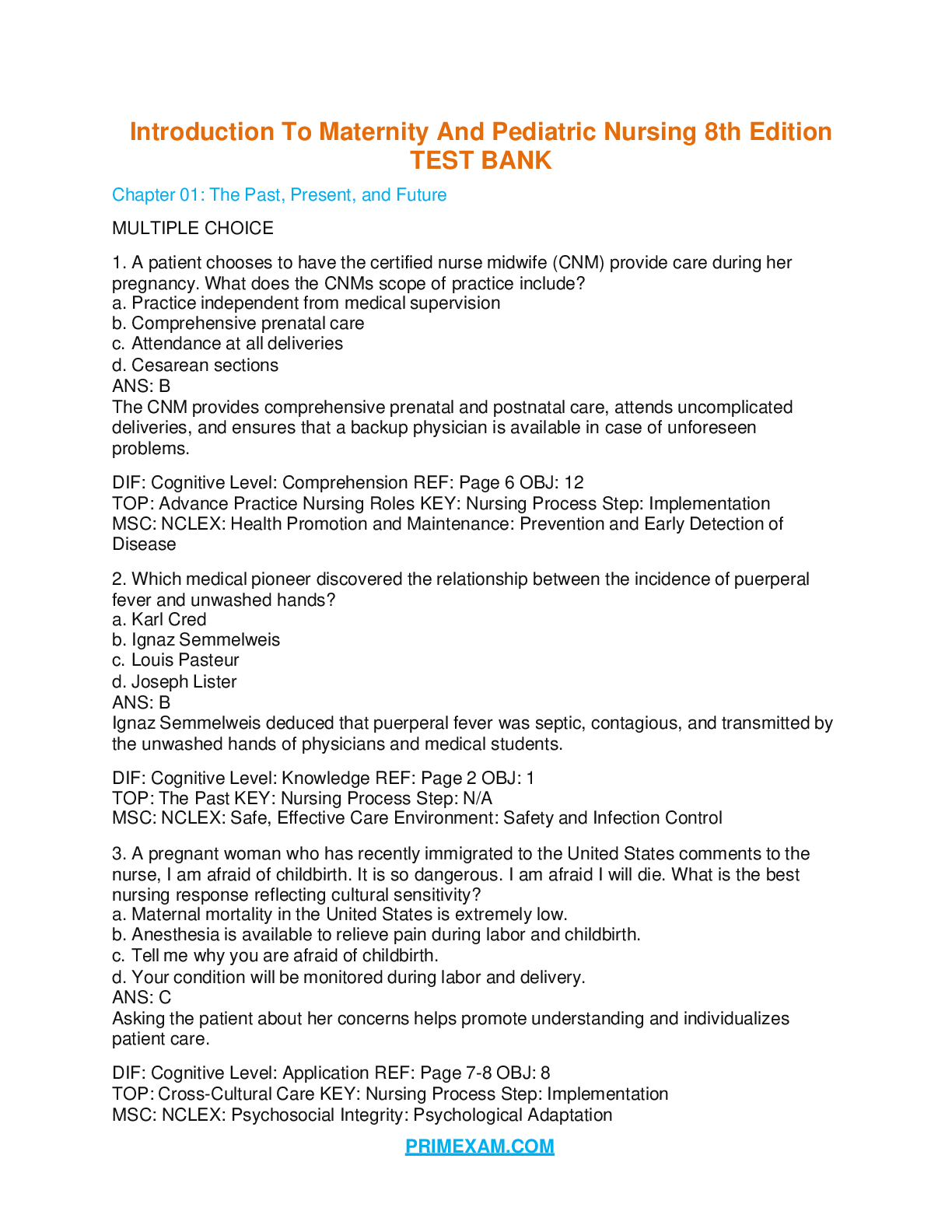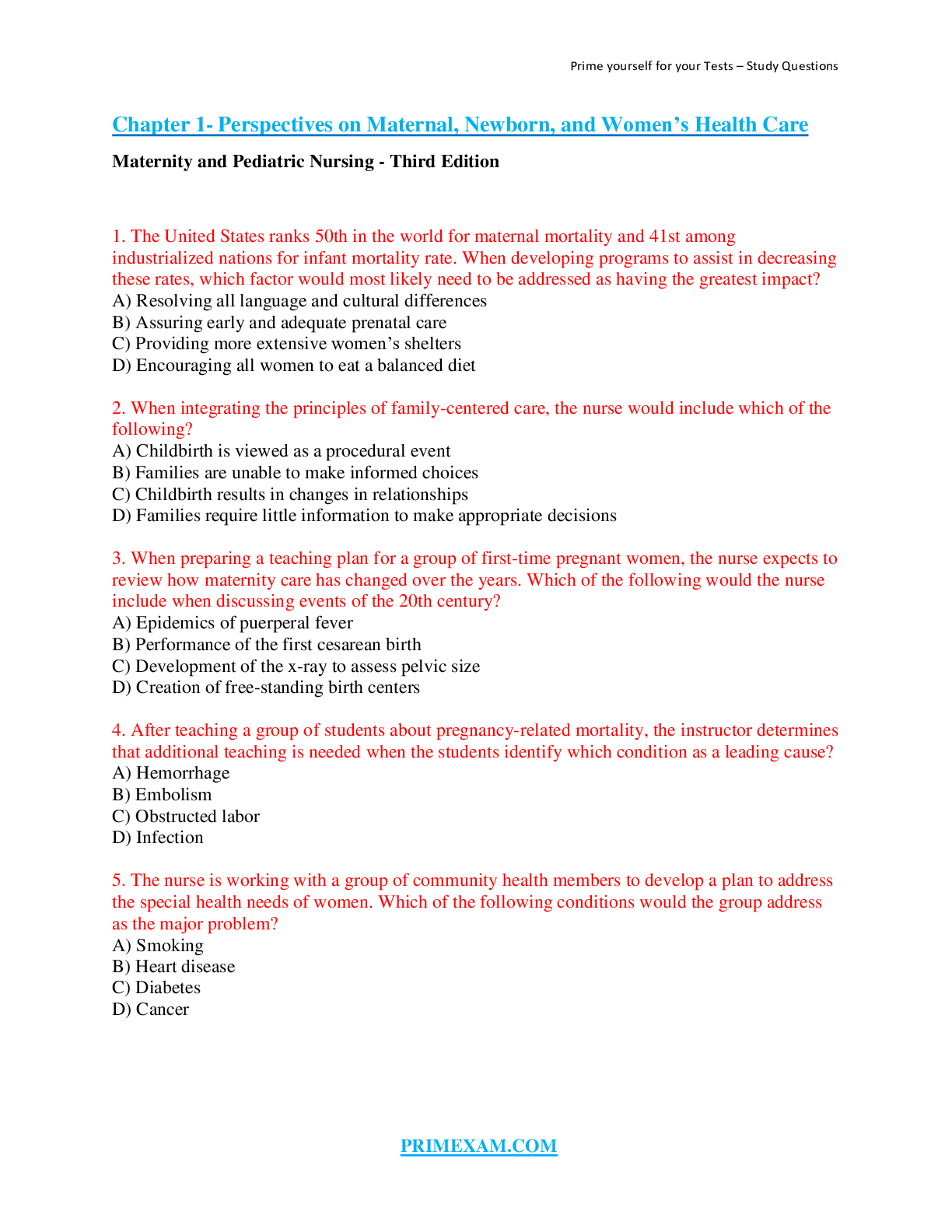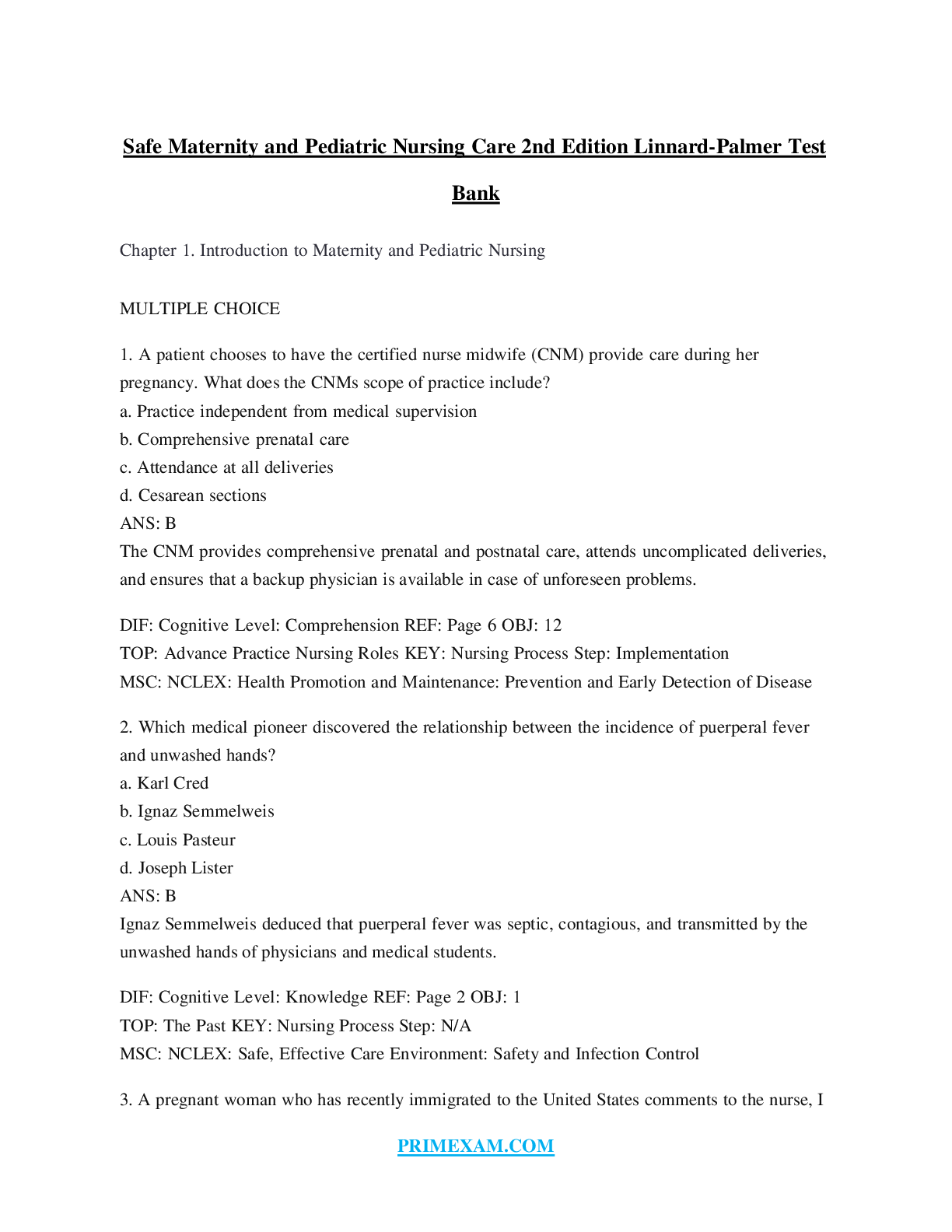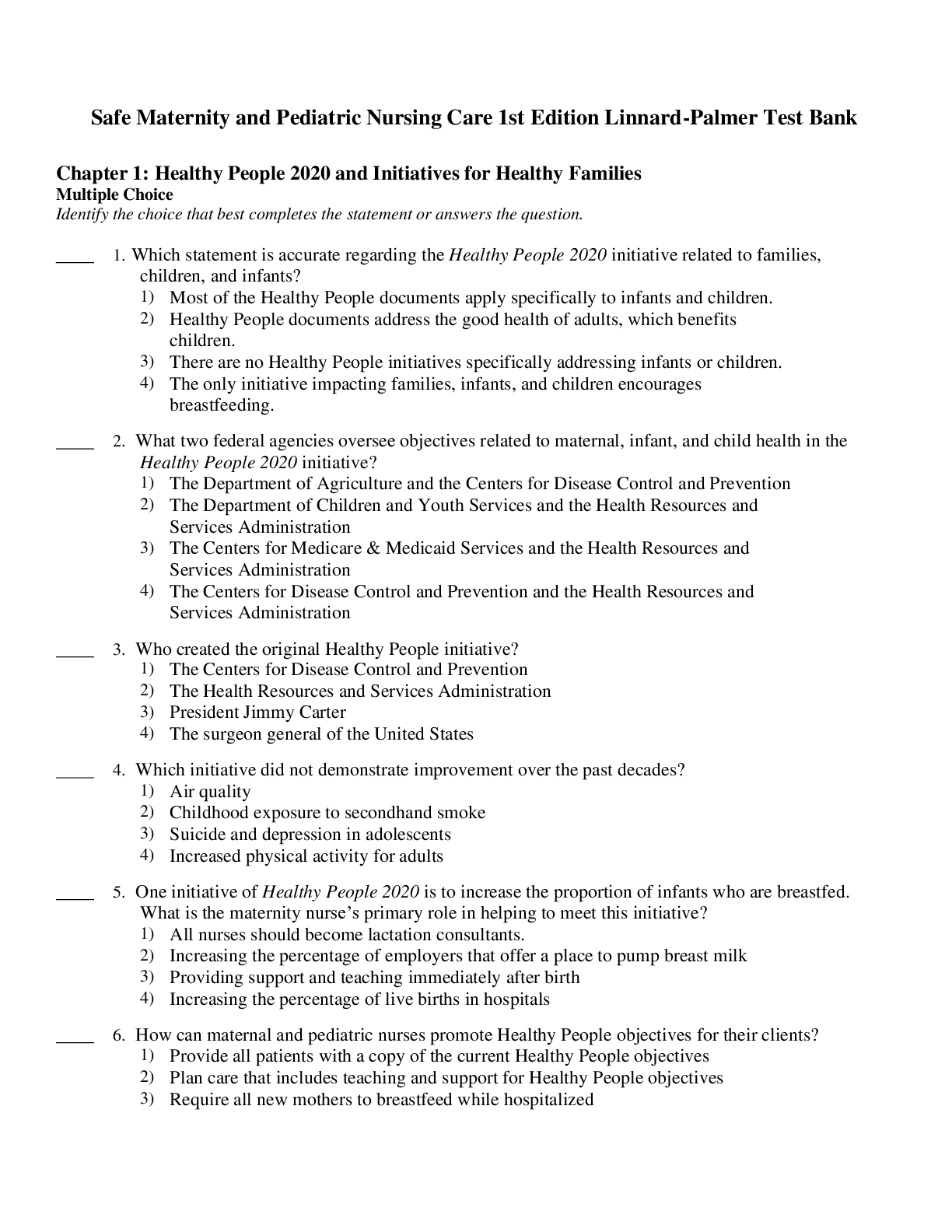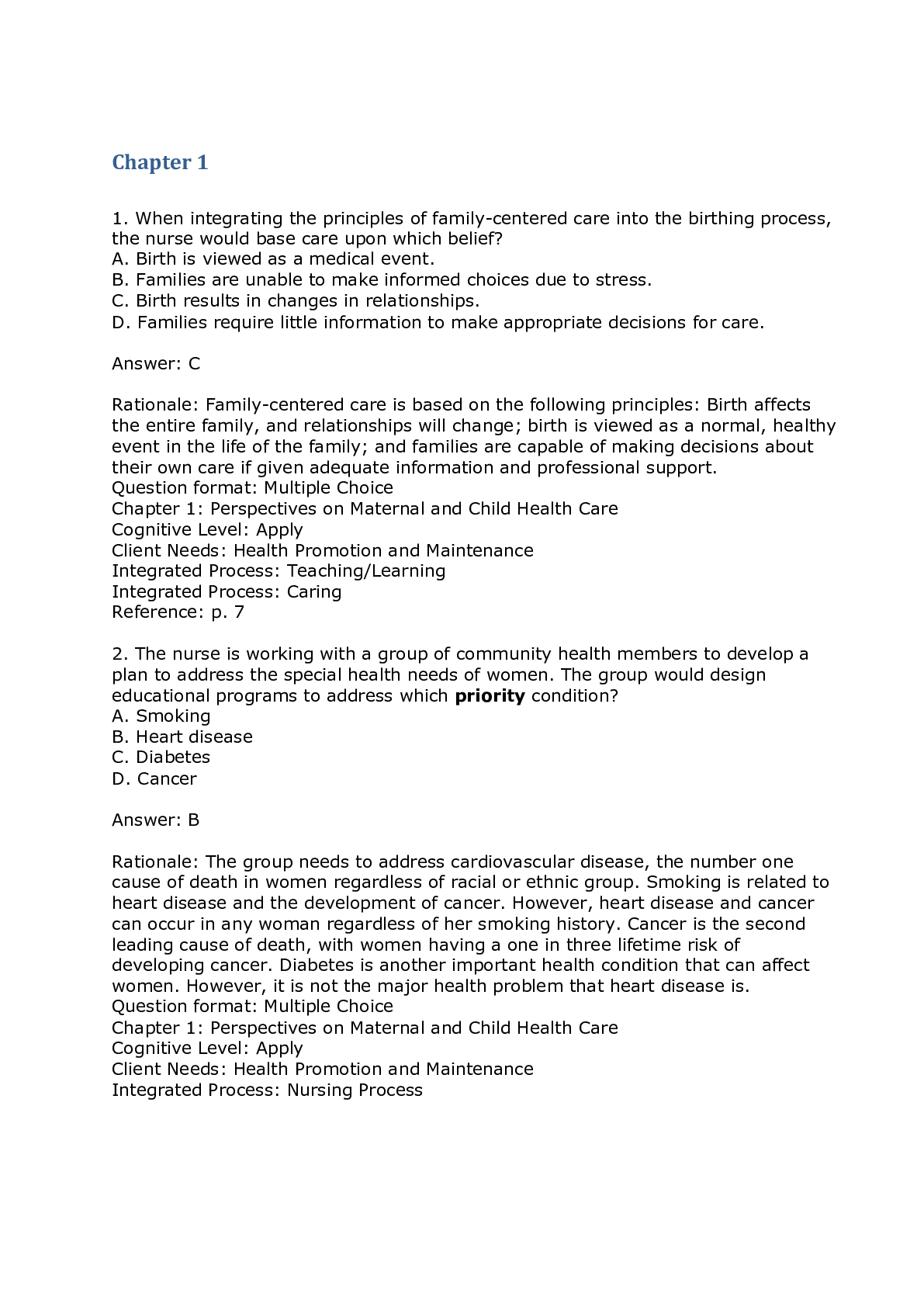*NURSING > TEST BANK > Test Bank Introduction to Maternity and Pediatric Nursing 8e (by Leifer) Human Reproductive Anatomy (All)
Test Bank Introduction to Maternity and Pediatric Nursing 8e (by Leifer) Human Reproductive Anatomy and Physiology,100% CORRECT
Document Content and Description Below
Test Bank Introduction to Maternity and Pediatric Nursing 8e (by Leifer) Human Reproductive Anatomy and Physiology MULTIPLE CHOICE 1. A 14-year-old boy is at the pediatric clinic for a checkup. Wh... at physical changes of puberty will the nurse indicate are related to the production of testosterone? a. Stimulation of production of white cells and platelets b. Promotion of growth of small bones c. Increase in muscle mass and strength d. Decrease in production of sebaceous gland secretions ANS: C Testosterone increases muscle mass, promotes strength and growth of long bones, and enhances production of red blood cells. DIF: Cognitive Level: Knowledge REF: Page 22 TOP: Male Reproductive System KEY: Nursing Process Step: Data Collection MSC: NCLEX: Health Promotion and Maintenance: Growth and Development 2. The nurse is educating high school students about puberty. What will the nurse indicate regulates the production of sperm and secretion hormones? a. Testes b. Vas deferens c. Ejaculatory ducts d. Prostate gland ANS: A The testes have two functions: manufacture of spermatozoa and secretion of androgens. DIF: Cognitive Level: Knowledge REF: PageN2U3RSINGTB.COM TOP: Male Reproductive System KEY: Nursing Process Step: Implementation MSC: NCLEX: Health Promotion and Maintenance: Growth and Development 3. The nurse is speaking with a couple trying to conceive a child. What will the nurse remind the couple is a factor that can decrease sperm production? a. Infrequent sexual intercourse b. The man not being circumcised c. The penis and testes being small d. The testes being too warm ANS: D The scrotum is suspended away from the perineum to lower the temperature of the testes for sperm production. DIF: Cognitive Level: Comprehension REF: Page 24 TOP: Male Reproductive System KEY: Nursing Process Step: Implementation MSC: NCLEX: Physiological Integrity: Reduction of Risk 4. When describing the female reproductive tract to a pregnant woman, the nurse would explain that which uterine layer is involved in implantation? a. Perimetrium b. Endometrium c. Myometrium d. Internal os ANS: B The endometrium is the inner mucosal layer of the uterus that is governed by cyclical hormonal changes. It is functional during menstruation and during the implantation of a fertilized ovum. DIF: Cognitive Level: Knowledge REF: Page 23 TOP: Female Reproductive System KEY: Nursing Process Step: Implementation MSC: NCLEX: Health Promotion and Maintenance: Growth and Development 5. A group of nursing students plans to teach a class of sixth-grade girls about menstruation. What correct information will the nursing students teach to the class? a. Menarche usually occurs around 12 years of age. b. Ovulation occurs regularly from the very first cycle. c. A regular cycle is established by the third period. d. Typically, menstrual flow is heavy and lasts up to 10 days. ANS: A The beginning of menstruation, called menarche, occurs at about 12 years of age. Early cycles are irregular and anovulatory. DIF: Cognitive Level: Comprehension REF: Page 29 TOP: Female Reproductive Cycle and Menstruation KEY: Nursing Process Step: Planning MSC: NCLEX: Health Promotion and Maintenance: Growth and Development 6. A 10-year-old girl asks the nurse, What is the first sign of puberty? What is the correct nursing response? a. An increase in height b. Breast development c. Appearance of axillary hair d. The first menstrual period ANS: B The first outward change of puberty in girls is the development of breasts at about 10 to 11 years of age. DIF: Cognitive Level: Knowledge REF: Page 23 TOP: PubertyFemale KEY: Nursing Process SNteUpR: SImINpGleTmBe.CnOtaMtion MSC: NCLEX: Health Promotion and Maintenance: Growth and Development 7. A 12-year-old female pediatric patient experienced menarche 3 months ago. Her mother voices concern to the pediatric office nurse regarding the irregularity of her daughters menstrual cycle. What is the nurses best response? a. Worrying is not the answer. b. I will talk to the pediatrician about a gynecological referral. c. I can only discuss this with your daughter. d. Early cycles are often irregular. ANS: D Early cycles are often irregular and may be anovulatory. Regular cycles are usually established within 6 months to 2 years of the menarche. In an average cycle, the flow (menses) occurs every 28 days, plus or minus 5 to 10 days. DIF: Cognitive Level: Application REF: Page 29 TOP: Menstrual Cycle KEY: Nursing Process Step: Implementation MSC: NCLEX: Health Promotion and Maintenance: Growth and Development 8. Which hormone initiates the maturation of the ovarian follicle? a. Estrogen b. Follicle-stimulating hormone c. Progesterone d. Luteinizing hormone ANS: B Follicle-stimulating hormone (FSH) stimulates the maturation of a follicle. DIF: Cognitive Level: Knowledge REF: Page 29 TOP: Female Reproductive Cycle KEY: Nursing Process Step: N/A MSC: NCLEX: Health Promotion and Maintenance: Growth and Development 9. What statement indicates a woman has correct information about oogenesis? a. Women make fewer ova as they age. b. Women have all of their ova at the time they are born. c. Ova production begins at birth and continues until puberty. d. New ova are made every month from puberty to climacteric. ANS: B Oogenesis (formation of immature ova) does not occur after fetal development. Females are born with about 2 million immature ova, which rapidly reduce by adulthood. DIF: Cognitive Level: Comprehension REF: Page 27 TOP: Female Reproductive Cycle KEY: Nursing Process Step: Evaluation MSC: NCLEX: Health Promotion and Maintenance: Growth and Development 10. A pregnant woman asks the nurse, Will I be able to have a vaginal delivery? The nurse knows that which is the most favorable pelvic type for vaginal birth? a. Gynecoid b. Android c. Anthropoid d. Platypelloid ANS: A The gynecoid pelvis is the typical female pelvis and is most favorable for vaginal birth. DIF: Cognitive Level: Knowledge REF: Page 27 TOP: Female Reproductive System KEY: Nursing Process Step: Implementation MSC: NCLEX: Health Promotion and MainteNnaUnRcSe:INPGreTvBen.CtiOoMn and Early Detection of Disease 11. A mother is anxious about her ability to breastfeed after her child is born because of her small breast size. What would be an important point to teach this mother? a. Milk is produced in ducts and lobules regardless of breast size. b. Supplementing breastfeeding with formula allows the infant to receive adequate nutrition. c. Breast size can be increased with exercise. d. Drinking extra milk during pregnancy allows breasts to produce adequate amounts of milk. ANS: A Breast size does not influence the ability to secrete milk. DIF: Cognitive Level: Comprehension REF: Page 29 TOP: Female Reproductive System KEY: Nursing Process Step: Implementation MSC: NCLEX: Psychosocial Integrity: Psychosocial Adaptation 12. For what is the decrease in estrogen and progesterone during the menstrual cycle responsible? a. Degeneration of the corpus luteum b. Ovulation c. Follicle maturation d. Shedding of the endometrium ANS: D The fall in estrogen and progesterone causes the endometrium to break down, resulting in menstruation. DIF: Cognitive Level: Comprehension REF: Page 29 TOP: Female Reproductive Cycle KEY: Nursing Process Step: Implementation MSC: NCLEX: Health Promotion and Maintenance: Growth and Development 13. The nurse is assisting with pelvic inlet measurements on a pregnant woman. What measurement will provide the nurse with information about whether the woman can deliver vaginally? a. Diagonal conjugate b. Obstetric conjugate c. Transverse diameter d. Anteroposterior diameter ANS: B This measurement determines if the fetus can pass through the birth canal. DIF: Cognitive Level: Comprehension REF: Page 28 TOP: Female Reproductive System KEY: Nursing Process Step: Implementation MSC: NCLEX: Health Promotion and Maintenance: Prevention and Early Detection of Disease 14. The nurse has explained menstruation to a 13-year-old girl. What statement indicates the girl needs additional education? a. Periods last about 5 days. b. My cycle should get regular in 6 months. c. I should expect heavy bleeding with clots. d. Periods come about every 4 weeks. ANS: C Clots are not normally seen in menstrual discharge. A normal menstrual flow is 30 to 40 mL blood and 30 to 50 mL serous fluid. DIF: Cognitive Level: Comprehension REF: Page 29 TOP: Female Reproductive Cycle KEY: Nursing Process Step: Evaluation MSC: NCLEX: Health Promotion and Maintenance: Growth and Development 15. A mother asks the nurse, When will I know my child has entered puberty? What will the nurse state based on an understanding of changes associated witNhUpRuSbIeNrtGy?TB.COM a. Your daughter will have her first period. b. Youll recognize puberty by the mood swings. c. The child becomes interested in the opposite sex. d. Secondary sex characteristics, such as pubic hair, appear. ANS: D Puberty begins when the secondary sex characteristics appear. Puberty ends when mature sperm are formed in the male and when regular menstrual cycles occur in the female. DIF: Cognitive Level: Comprehension REF: Page 22 TOP: Puberty KEY: Nursing Process Step: Implementation MSC: NCLEX: Health Promotion and Maintenance: Growth and Development 16. A nurse is planning to teach couples about the physiology of the sex act. What correct information will the nurse provide? a. Fertilization of an ovum requires penetration by several sperm. b. An ovum must be fertilized within 24 hours of ovulation. c. It takes 4 to 5 days for sperm to reach the fallopian tubes. d. Sperm live for only 24 hours following ejaculation. ANS: B After ovulation, the egg lives for only 24 hours. Sperm must be available during that time if fertilization is to occur. DIF: Cognitive Level: Comprehension REF: Page 31 TOP: Physiology of the Sex Act KEY: Nursing Process Step: Planning MSC: NCLEX: Health Promotion and Maintenance: Growth and Development 17. A newly married couple tells the nurse they would like to wait a few years before starting a family. Which statement made by the man indicates an understanding about sexual activity and pregnancy? a. My wife cant get pregnant if I withdraw before climax. b. A man can secrete semen before ejaculation. c. If we dont have intercourse very often, my wife wont get pregnant. d. It is safe to ejaculate outside the vagina. ANS: B Semen may be secreted during sexual intercourse before ejaculation. DIF: Cognitive Level: Comprehension REF: Page 31 TOP: Male Reproductive System KEY: Nursing Process Step: Evaluation MSC: NCLEX: Physiological Integrity: Reduction of Risk 18. The nurse is aware that the diagonal conjugate is 12 centimeters. What is the measurement in centimeters of the obstetric conjugate? a. 10 to 10.5 b. 11 to 11.5 c. 12.5 to 13 d. 14 to 14.5 ANS: A The obstetric conjugate is approximately 1.5 to 2 centimeters shorter than the diagonal conjugate. DIF: Cognitive Level: Knowledge REF: Page 28 TOP: Obstetric Conjugate KEY: Nursing Process Step: Implementation MSC: NCLEX: Health Promotion and Maintenance: Prevention and Early Detection of Disease 19. The nurse uses a diagram to demonstrate the fimbriae when teaching nursing students about the female anatomy. What is true about fimbriae? a. They form the passageway for the sperm toNmUeRetStIhNeGoTvBu.mCO. M b. They are the site of fertilization. c. They are fingerlike projections that capture the ovum. d. They propel the egg through the fallopian tube. ANS: C Fimbriae are the fingerlike projections from the infundibulum that capture the ovum at ovulation and conduct i into the fallopian tube. DIF: Cognitive Level: Comprehension REF: Page 27 TOP: Fimbriae KEY: Nursing Process Step: Implementation MSC: NCLEX: Health Promotion and Maintenance: Growth and Development 20. What will the nurse explain to a 12-year-old patient when describing what characterizes nocturnal emissions? a. A drop in testosterone level b. Sexual stimulation c. Absence of sperm in ejaculate d. Association with violent dreams ANS: C Nocturnal emissions, also known as wet dreams, occur without sexual stimulation and contain no sperm. Testosterone levels are constant until midlife. DIF: Cognitive Level: Comprehension REF: Page 23 TOP: Nocturnal Emissions KEY: Nursing Process Step: Implementation MSC: NCLEX: Health Promotion and Maintenance: Growth and Development 21. The nurse is educating a pregnant patient who expects to breastfeed. The nurse knows that when a patient breastfeeds, which portions of the breast secrete milk? a. Lactiferous sinuses b. Lobes c. Montgomerys glands d. Alveoli ANS: D The alveoli secrete milk. DIF: Cognitive Level: Knowledge REF: Page 29 TOP: Milk Secretion KEY: Nursing Process Step: Implementation MSC: NCLEX: Health Promotion and Maintenance: Growth and Development 22. Where are the secretions responsible for nourishing sperm excreted from? a. Vas deferens b. Epididymis c. Cowpers gland d. Scrotum ANS: C The Cowpers gland secretions nourish the sperm. DIF: Cognitive Level: Knowledge REF: Page 24 TOP: Cowpers Gland KEY: Nursing Process Step: Implementation MSC: NCLEX: Health Promotion and Maintenance: Growth and Development 23. What signifies the end of puberty for a male? a. Facial hair is evident. b. Erections can be sustained. c. Ejaculate is greater than 5 mL. d. Mature sperm are formed. ANS: D NURSINGTB.COM Puberty ends for a male when mature sperm are formed by the testes. DIF: Cognitive Level: Knowledge REF: Page 22 TOP: End of Puberty KEY: Nursing Process Step: Implementation MSC: NCLEX: Health Promotion and Maintenance: Growth and Development 24. How long does sperm remain viable in the female reproductive tract? a. 12 hours b. 1 day c. 2 days d. 4 days ANS: D Sperm can remain viable in the reproductive tract of the female for as long as 4 to 5 days. DIF: Cognitive Level: Knowledge REF: Page 31 TOP: Viability of Sperm KEY: Nursing Process Step: Implementation MSC: NCLEX: Health Promotion and Maintenance: Growth and Development 25. The nurse encourages the members of a prenatal class to seriously consider breastfeeding. What does breast milk provide in addition to nourishment for the infant? a. Maternal antibodies b. Stimulus for red blood cell production c. Endorphins that soothe the infant d. Hormones that stimulate growth ANS: A Breast milk provides maternal antibodies to the infant that give the child acquired immunity from some diseases for several months. DIF: Cognitive Level: Comprehension REF: Page 29 TOP: Properties of Breast Milk KEY: Nursing Process Step: Implementation MSC: NCLEX: Health Promotion and Maintenance: Prevention and Early Detection of Disease 26. A female patient reports her menstrual cycle consistently occurs every 32 days. What day of her cycle can the woman anticipate ovulation? a. 14 b. 16 c. 18 d. 20 ANS: C Ovulation occurs when a mature ovum is released from the follicle about 14 days before the onset of the next menstrual period. DIF: Cognitive Level: Analysis REF: Page 29 TOP: Menstrual Cycle KEY: Nursing Process Step: Evaluation MSC: NCLEX: Health Promotion and Maintenance: Growth and Development MULTIPLE RESPONSE 27. The nurse conducting a sex education class for junior high students describes some cultural rites celebrating the entry to adulthood. What information would the nurse include? (Select all that apply.) a. Bar mitzvah b. Displays of bravery c. Receiving part of their inheritance d. Ritual circumcision e. Displays of self-defense NURSINGTB.COM ANS: A, B, D, E Some cultures celebrate the entry to adulthood with rites such as displays of strength, bravery, self-reliance, and self-defense. Ritual circumcisions and bar and bat mitzvahs are also entry rites to adulthood. Lack of such rituals can sometimes confuse young people because there is no evidence of acceptance as an adult. DIF: Cognitive Level: Knowledge REF: Page 22 TOP: Rites of Passage KEY: Nursing Process Step: Implementation MSC: NCLEX: Health Promotion and Maintenance: Growth and Development 28. The nurse is reading a pregnant patients history and physical. What information does the nurse recognize might indicate the need for a cesarean delivery? (Select all that apply.) a. History of childhood rickets b. Immobile coccyx c. Prepregnant weight of 100 pounds d. Avid horse rider e. Pelvic fracture 3 years ago ANS: A, B, E Pelvic conditions that may predispose to a cesarean delivery are childhood rickets, pelvic fracture, and immobile coccyx. DIF: Cognitive Level: Comprehension REF: Page 29 TOP: Pelvic Conditions Predisposing Cesarean Delivery KEY: Nursing Process Step: Data Collection MSC: NCLEX: Health Promotion and Maintenance: Prevention and Early Detection of Disease 29. What are considered to be functions of the fallopian tubes? (Select all that apply.) a. Passage for sperm to meet ova b. Passage for ovum to uterus c. Safe environment for zygote d. Restriction for only one ovum to enter uterus e. Site for fertilization ANS: A, B, C, E The fallopian tube provides passage for both sperm and ova, offering an optimum place for fertilization and a safe environment for the zygote. DIF: Cognitive Level: Knowledge REF: Page 27 TOP: Function of Fallopian Tubes KEY: Nursing Process Step: Implementation MSC: NCLEX: Health Promotion and Maintenance: Growth and Development 30. The nurse is providing an inservice to students beginning their obstetric clinical rotation. Using a diagram, the nurse points out parts of the female pelvis. What will the nurse include? (Select all that apply.) a. Two innominates b. Obstetric conjugate c. Sacrum d. Perimetrium e. Coccyx ANS: A, C, E The bones of the pelvis are two innominates, the sacrum, and the coccyx. DIF: Cognitive Level: Knowledge REF: Page 27 TOP: Bones of the Pelvis KEY: Nursing Process Step: Implementation MSC: NCLEX: Health Promotion and Maintenance: Growth and Development 31. The nurse explains that testosterone is respNoUnRsiSbIlNe GfoTrBm.CaOleMs exceeding females in which aspects? (Select all that apply.) a. Strength b. Height c. Mental concentration d. Hematocrit levels e. Agility ANS: A, B, D DIF: Cognitive Level: Knowledge REF: Page 23 OBJ: 2 TOP: Effects of Testosterone KEY: Nursing Process Step: Implementation MSC: NCLEX: Health Promotion and Maintenance: Growth and Development 32. A patient is being seen by her health care provider for a suspected vaginal infection. What will the nurse include when educating this patient on factors that affect the vaginal pH? (Select all that apply.) a. Antibiotic therapy b. Frequent douching c. Exercise d. Jet lag e. Use of vaginal sprays ANS: A, B, E The vagina is self-cleansing and during the reproductive years maintains a normal acidic pH of 4 to 5. The self cleansing activity may be altered by antibiotic therapy, frequent douching, and excessive use of vaginal sprays, deodorant sanitary pads, or deodorant tampons. DIF: Cognitive Level: Application REF: Page 25 TOP: Female Reproductive Organs KEY: Nursing Process Step: Assessment MSC: NCLEX: Health Promotion and Maintenance: Prevention and Early Detection of Disease COMPLETION 33. When the nurse reads in the history and physical of a pregnant patient that she has a platypelloid pelvis, the nurse is aware that this pelvis has a narrow diameter, making a vaginal birth unlikely. ANS: anteroposterior The platypelloid pelvis is very narrow from front to back (anteroposterior). The shape of this pelvis makes vaginal delivery unlikely. DIF: Cognitive Level: Comprehension REF: Page 27 OBJ: 8 TOP: Platypelloid Pelvis KEY: Nursing Process Step: Data Collection MSC: NCLEX: Health Promotion and Maintenance: Prevention and Early Detection of Disease 34. In males the follicle-stimulating hormone (FSH) and the luteinizing hormone (LH) from the anterior pituitary stimulate testosterone production in the cells of the testes. ANS: Leydig The Leydig cells in the testes are stimulated by the FSH and LH to produce testosterone. DIF: Cognitive Level: Knowledge REF: Page 24 TOP: Leydig Cells KEY: Nursing Process Step: N/A MSC: NCLEX: Health Promotion and Maintenance: Growth and Development 35. The is a period of years during which the womans ability to reproduce gradually declines. ANS: climacteric NURSINGTB.COM The climacteric is a period of years during which the womans ability to reproduce gradually declines. DIF: Cognitive Level: Knowledge REF: Page 29 TOP: Female Reproduction KEY: Nursing Process Step: N/A MSC: NCLEX: Health Promotion and Maintenance: Growth and Development 36. Where the labia majora and the labia minora meet is known as the fourchette or . ANS: obstetrical perineum Where the labia majora and the labia minora meet is known as the fourchette or obstetrical perineum. Lacerations in this area often occur during childbirth. DIF: Cognitive Level: Knowledge REF: Page 24 TOP: Female Anatomy KEY: Nursing Process Step: N/A MSC: NCLEX: Health Promotion and Maintenance: Growth and Development 37. The nurse outlines the phases of the sexual response. Arrange the phases in order of occurrence. Put a comma and space between each answer choice (a, b, c, d, etc.) a. Nipples become erect. b. Involuntary muscle spasms occur. c. Engorgement resolves. d. Heart rate slows. e. Skin flushes. ANS: A, E, B, C, D DIF: Cognitive Level: Comprehension REF: Page 31 TOP: Sexual Response KEY: Nursing Process Step: Implementation MSC: NCLEX: Physiological Integrity: Physiological Adaptation NURSINGTB.COM [Show More]
Last updated: 1 year ago
Preview 1 out of 19 pages

Reviews( 0 )
Document information
Connected school, study & course
About the document
Uploaded On
Jul 19, 2022
Number of pages
19
Written in
Additional information
This document has been written for:
Uploaded
Jul 19, 2022
Downloads
0
Views
31

